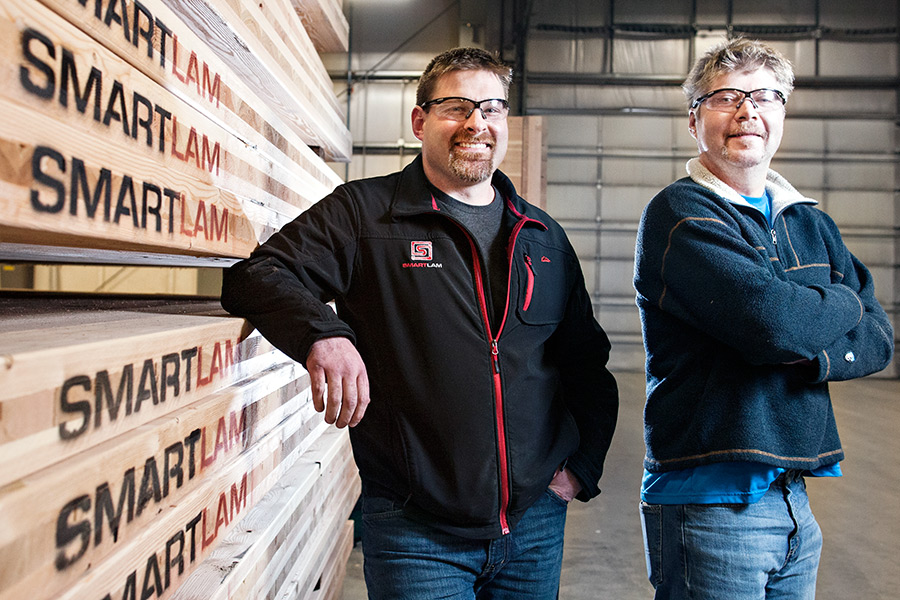COLUMBIA FALLS – The plant at SmartLam near U.S. Highway 2 here smells of timber, friction heat, and sometimes, glue. But underneath these powerful scents, there’s an undercurrent of something else, something precious and rare for a business only in its second year of operation: the smell of success.
In the last year, SmartLam, a cross-laminated timber production company, has started making profit, bumped up to full production, and made plans for a massive expansion that will increase production by at least four times.
And the good news doesn’t stop there. The company is putting together some new patentable technology to put its cross-laminated timber – extremely durable panels made from industrial lumber stacked together at strong angles and glued together – into new areas of demand.
“We have a product that is going to drive markets,” general manager Casey Malmquist said. “There are so many possibilities.”
SmartLam started up in 2012 at its current location in a WBC warehouse, and began commercial production in February 2013. The panels they create are so durable and mobile that they are popular as oil drilling rig pads, pipeline construction platforms and temporary roadways and bridges.
The company is one of only three cross-laminated timber (CLT) facilities in North America – the other two are in Canada – and has products in the Dakotas, Texas, Louisiana, Oklahoma, Colorado, Pennsylvania, Alaska, Alberta, Mexico, and Saudi Arabia.
Malmquist said there is a chance that SmartLam might even expand to South America in the future.
CLT is a popular building method in Europe, and America is just starting to catch on. The panels can be used to construct incredibly strong buildings and bridges; anything structural can use the panels.
Jason Herman, production manager at SmartLam, said the company is working with the state Department of Natural Resources and Conservation to come up with a solution to keep streambeds intact during logging projects; normally, the logging crews would dig up the streambed and put in a culvert for the water so the trucks and equipment can drive over.
“Now, we’ve designed some bridges for logging,” Herman said.
This means the streambeds stay where they are, and the bridge can be removed when the project is completed. Malmquist noted that such bridges are already in use for F.H. Stoltze Land and Lumber Co. logging projects, which is a neat circle, since the wood used to build the bridge came from Stoltze.
In fact, SmartLam is breathing life into the local timber industry with its voracious need for timber.
“We’re buying everything (Stoltze) can produce in two-by-eights,” Malmquist said.
But as the SmartLam production line becomes more automated, which it will once the company moves into its new building, expected to be between 120,000 and 160,000 square feet, the specific two-by-eight dimensions will become less important, he said.
To keep the company pumping out 1 million to 1.2 million board feet each month, SmartLam sources its timber from logging companies within 200 miles of the plant. With the new facility, Malmquist and Herman said they expected the output to at least quadruple, and maybe even more.
That also means the current amount of 36 full-time employees will likely double, Malmquist said, and with each of those jobs comes a ripple effect of other jobs, such as the loggers or truckers carrying the product.
“It’s pretty significant,” he said.
One of the benefits of cross-laminated timber is that its source is renewable, and Herman also noted that the current plant is waste free. The timber residuals are either sold as construction material for other value-added products or burned in the plant’s biomass heater, which it purchased with a $40,000 matching grant from the DNRC.
The sustainability of the cross-laminated panels is turning the heads of builders in the United States, Malmquist said, because they are more eco-friendly than a steel or concrete structure.
Really, when it comes to the applications for these tough panels, the sky is the limit, Herman said; there are few, if any, preconceptions about what cross-laminated timber can do, he said, and that makes the possibilities endless.
“Dealing with something so new, there’s been a lot of innovation,” Malmquist said.
SmartLam has taken the technical detail traditionally found in European CLT plants and married it with the American drive for production. And as the company grows, so will its workforce.
Already, SmartLam is working with Flathead Valley Community College on programs that could help produce a technically skilled workforce, and recently donated a few CLT panels to the wood shop class at Columbia Falls High School for a shed project.
“That shed’s probably going to be there for 500 years,” Malmquist said.
Though the company is experiencing success, Malmquist and Herman were quick to attribute it to the Flathead Valley. From the beginning, there were the investors, the local workforce, public programs and timber companies cheering them on.
The manufacturing sector has also been stalwart, he said.
“It’s a tight-knit community,” Malmquist said. “And it’s just been buoyant.”
As for whether SmartLam will be one of the catalysts it takes to get the Flathead timber industry moving again, Malmquist said he’s hopeful the company will continue to grow and expand in the valley.
“In order to be successful, it takes the entire community,” Malmquist said.
For more information about SmartLam, visit www.smartlam.com.
